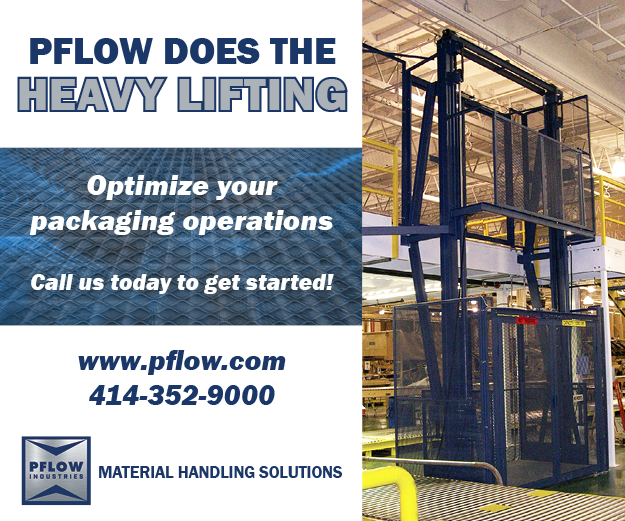Don’t Forget the Middleman!
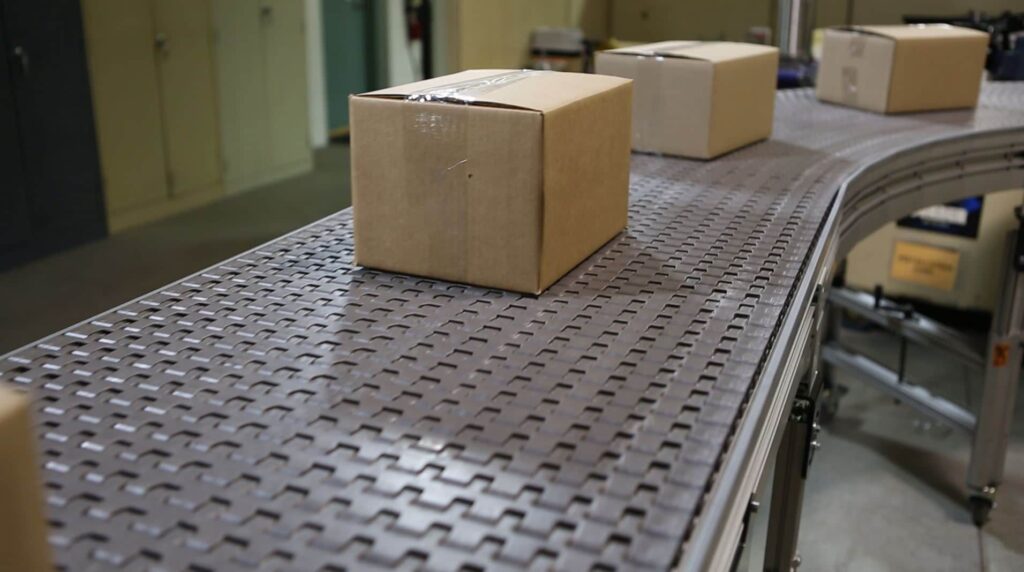
Conveyor systems orient and sort products, and integrate all the different aspects of a packaging line. Image courtesy of Dorner.
Intuitive Conveyor Systems Are Key in the Packaging Line of the Future
By Marco Pardo, a product manager at Dorner
With all the talk of automation, e-commerce and other trends in modern packaging, the “middleman” role played by conveyors at times may not seem like a top priority. However, a solid, precise, intuitive conveyor system is a crucial component of bringing all the different aspects of a packaging line together. An effective conveyor system not only moves product from one point to another, it adapts to the different components and complements the line’s overall efficiency by also orienting and sorting that product to be in the correct location for the next step of the packaging process.
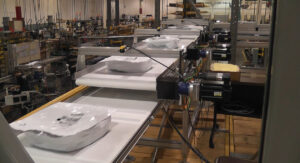
E-commerce conveyors consistently handle parcels and packages of various sizes. Image courtesy of Dorner.
Finding the right conveyor
Selecting the right conveyor for your application may seem daunting, but there are ways to quickly narrow the search down. Many of the primary factors to consider are focused on the products moving through the line.
It’s important to note the size and weight of the product itself, as well as the size and weight the conveyor will need to support when multiple products are on the line at a time. Speed is also an important factor, as the conveyor needs to keep up with the required throughput without compromising on safety or proper placement.
After establishing the basics of the conveyor’s necessary capabilities, consider the workspace and other pieces of the packaging line. If the machine needs to work around other equipment without taking up too much space, a flexible chain conveyor, which can safely move products around sharp turns, may be the right choice. In applications with more automation, precision timing and pallet system conveyors can be great options with their abilities to stagger products and properly orient pallets respectively.
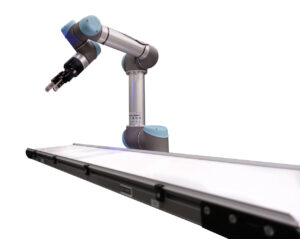
Dorner Cobot Integration: Low profile conveyors are ideal for cobot integration. Image courtesy of Dorner.
Bridging the automation gap
Robots and cobots are increasingly being incorporated into packaging lines, and the benefits are quickly becoming apparent. Ongoing labor shortages have made a robot’s reliability crucial to keeping lines open and maintaining throughput quotas.
Automation also increases safety by eliminating the need for employees to repeatedly bend over and put strain on their backs by lifting and stacking pallets. Strain injuries are almost inevitable in manual stacking roles. They can be severe and can cost the company in both lost production and worker’s compensation.
Even with a team of all-star employees and the luck to avoid injuries, adding automation can help increase production while pulling staff off these sometimes menial, strenuous tasks. Full automation can work in many cases, but even automated solutions that are smaller in scale can make a big impact. A cobot can work alongside operators, increasing throughput safely within a small footprint, and an autonomous maneuverable robot (AMR) or autonomous guided vehicle (AGV) can transport items from one station to another, all while the employees normally assigned these tasks are able to put their skills to better use.
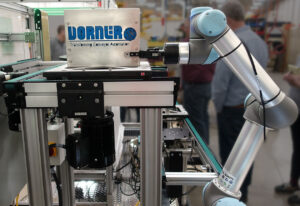
Precision pallet systems ensure accurate movement of pallets for interfacing with cobots. Image courtesy of Dorner.
Finding the right balance
An overall setup that works for both human and robot components should be considered when moving to partial automation. All the pieces around the newly automated task need to be adjusted, and conveying must be done in a way that is compatible with the robots, but also safe for employees. Finding this balance is critical when adopting new technologies into the packaging line.
All these applications, both partial and full automation, are changing the scene in the packaging industry, and early adopters are already seeing massive benefits. However, a shortcoming of automated solutions is the lack of ability to perform complicated tasks in a more accurate and cost-effective way than humans.
Automation is best used to make repeated motions based on cues read by a sensor. It relies heavily on products being consistently positioned correctly at a specific time and location. If a package is on the wrong side of the conveyor or improperly oriented, the robot may perform its function incorrectly or not at all.
Some of these challenges can be mediated by human interference, but having an employee stuck monitoring alignment so the robot can do its job defeats the purpose of automating in the first place. A conveyor can consistently bring the precision and intuition to get the product where it needs to be, when it needs to be there and with the proper consistency for the next machine to perform its job effectively.
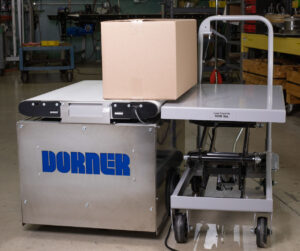
Conveyors with the ability to be wider than they are long are ideal for mounting onto AGVs. Image courtesy of Dorner.
Embracing e-commerce
In addition to being important for increasing automation, a well-designed conveying solution has a huge impact on adapting a packaging set-up for e-commerce. Moving into a more digital space generally increases the required throughput and necessitates more of a warehouse-style packaging and storage line. A conveyor system engineered for an e-commerce environment adapts to both changes to boost efficiency and overall harmony within the line.
Throughput does not just mean pushing out as many packages as possible. It also means ensuring that the packages are being delivered accurately and consistently. The standard for professionalism in packaging is high in e-commerce, with a box often serving as a customer’s first impression of the product and overall brand. A misapplied label or sloppy package are much bigger issues when the product skips the store and goes straight to the consumer.
Ensuring accuracy and proper alignment with a precision conveyance is critical to delivering perfect, repeatable results during end-of-line packaging.
Warehousing can also pose some unique packaging needs with pallets full of inventory moving through a massive space to be sorted for storing or shipping. Both the heavy load and need for precision make warehouses an ideal application for AGVs, many of which are now manufactured to include conveyors. By building a conveyor into the AGV, the gap between the final steps of packaging and the first steps of storing closes. Product can be delivered directly onto the vehicle and dropped off properly with no need for any outside interference.
Shaping the future
The manufacturing environment has changed drastically over the course of just a few years. Automation and e-commerce have reshaped packaging and brought with them both incredible opportunities and complicated challenges.
While adjusting to prepare a packaging line for the future, enhancing how it all comes together is the only way to ensure a cohesive line. And the first step toward making that happen is your conveyor system.
About the Author
Marco Pardo is a product manager at Dorner. He can be reached at marco.pardo@dorner.com; www.dornerconveyors.com.






